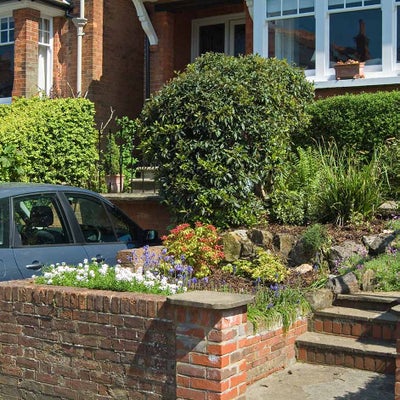
Quick facts
Five top plants
Choisya ternata AGM
Taxus baccatafor hedges
Lysimachia nummulariafor under cars
Pyruscalleryana ‘Chanticleer’ (narrow tree)
Pyracantha for wildlife
Introduction
You can combine paving for parking with an attractive garden with plants. Leave planting pockets in paving or gravel to ensure there is soil for them to grow in, rather than hardcore or a bed of concrete.
5 top tips for squeezing plants into the front garden
- Fill up the corners: you usually can't park here so plant instead
- Go up the wall: climbers and wall shrubs take up little space. And they don't only look great, they'll insulate your home too, saving on heating bills
- Hedge your bets: Rather than walls or fences, grow a hedge to filter out particulate (dust) pollution to help you breath more easily. It will provide a home for wildlife too
- Growing up: With a slender trunk, a tree can take your greenery up and over the cars
- No soil? Plant in containers: Even 100% paved gardens can be made greener by using containers
Practical considerations
1. Planting under cars
If the car is moved fairly regularly, then there are plants you can grow that will tolerate being parked over. These need to be low-growing so the car does not brush them, and tough enough to withstand the occasional running over. Try creeping Jenny, Lysimachia nummularia; bugle, Ajuga reptans; and thymes such as Thymus serpyllum. Just leave planting pockets in the paving or gravel to ensure there is soil for them to grow in, rather than hardcore or a bed of concrete.
2. Attract wildlife
Shrubs, trees and hedges provide shelter and nesting sites for birds and insects. With careful selection they can also provide food. Birds will eat berries from plants such as pyracantha, while a wide range of insects feast on the pollen and nectar produced by flowers. Aim to have plants in bloom from early spring to late autumn, and choose open, single flowers to ensure insects have easy access to their food. Good examples include catmint, Nepeta × faassenii; honeysuckle, Lonicera periclymenum; ivy, Hedera helix cultivars; and Aster novi-belgii.
See RHS Plants for Pollinators for more ideas.
3. Colourful containers
Pots can be placed anywhere, allowing plants to be grown in areas of the front garden that don’t have soil. For summer colour, plant such as petunias and nicotiana in late May. These can be replaced with pansies in September to keep the display going through the winter. If you want the containers to look good for more than one season, choose evergreen shrubs and plant into pots at least 45cm (18in) wide using John Innes No.2 .
Containers require watering and regular maintenance to do well.
4. Climbers and screening
Climbing plants can easily be used to dress bare walls and fences with decorative foliage and flowers. Secure trellis or wires to the support posts or wall before you plant, as most climbers will need something to hang on to. Try Clematisalpina cultivars, Hydrangea anomala subsp. petiolaris, ivy cultivars, and Ceanothus such as ‘Delight’.

Suitable plants
Trees
These are small trees with interest throughout the yea
- Ilex 'J. C. van Tol' AGM (holly)
- Magnolia × loebneri ‘Leonard Messel’ AGM
- Malus ‘Golden Hornet’ (crab apple)
- Prunus ‘Shôgetsu’ AGM (flowering cherry)
- Pyruscalleryana ‘Chanticleer’ (ornamental pear)
See Trees for Smaller Gardens for more ideas.
Shrubs
This selection is of tough evergreens that flower or have interesting leaves. They will all tolerate shade, apart from the lavender.
- Aucuba japonica
- Camellia × williamsii(for acid soil)
- Choisya ternata AGM
- Elaeagnus × ebbingeiAGM
- Lavender(for sun)
- Mahonia × media 'Charity’
- Skimmia
Hedges
Providing a barrier to street and neighbours, hedges can also help trap dusty pollution. Further choices can be found on our Hedges: selection profile and there's planting advice too.
- Berberis thunbergii
- Buxus sempervirens (box)
- Carpinus (hornbeam)
- Lonicera nitida
- Thuja plicata (western red cedar)
- Taxus baccata (yew)
Perennial plants that grow each year, flowering well, but do die back in the winter. They provide lots of colour through the summer and don't need replacing each year.
- Alchemilla mollis AGM (lady's mantle)
- Anemone hupehensis (Japanese anemone)
- Nepeta (catmint)
- Geraniums such as Rozanne
- Heuchera
- Stipa tenuissima (ornamental grass)
- Phormium (New Zealand flax)
Dry shade
Perhaps the toughest conditions to grow plants in, dry shade can be made beautiful with these stalwarts. For other choices, see Shade planting.
- Bergenia
- Cyclamen hederifolium
- Euonymus cultivars
- Lamium(dead nettle)
- Luzula sylvatica(wood sedge)
- Pachysandra
- Vinca minor ‘Illumination’ (periwinkle)










